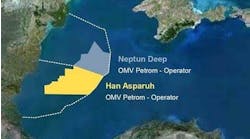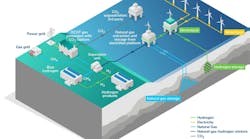Bud Curtis, David Elkins, Joe Nutt - Boots & Coots
Sunil Kumar Ahuja, Sanjay Bhatt - Oil and Natural Gas Corp. Ltd. (ONGC) India
A uniquely engineered kill and salvage operation employing a 150-hp ROV successfully secured a storm-damaged well and recovered a 217-ton (197-metric ton) BOP stack from more than 800 ft (244 m) of water in India’s Bay of Bengal.
In what may very well be an industry first, the multi-faceted project overcame myriad technical challenges to avert any potentially catastrophic HSE incidents, while killing the well unconventionally via stinger and retrieving the BOP, subsea tree, and wellhead. Underscoring the unprecedented complexity of the seven-month, operation was designing an out-of-the-ordinary procedure and specialized tools to kill the ONGC G-1-DB well where all post-storm subsurface components, including the BOP stack and drill pipe, were resting horizontally. Moreover, the BOP stack and casing stub were buried nearly completely beneath the extremely soft and fluid seabed that was blanketed with storm-driven debris. Accordingly, almost two months of excavation was necessary before a plan forward could be devised.
Owing to the unequaled obstacles the operation presented at every juncture, most of the required tools were customized and fabricated onboard either the Class II dynamically positioned ROV-deployment vessel or ONGC’s drilling rig. These included everything from the customized stinger used to kill the well, to the cutters and heavyweight slings needed to raise the BOP stack.
Unearthing BOP takes precedence
Climatic conditions frequently create havoc with exploration and production operations in the cyclone-prone Bay of Bengal, where surface and subsurface currents as strong as 4.5 knots have been recorded. The ONGC G-1-DB well site was no exception as enormous swells and currents from a late summer depression ultimately severed the riser near the BOP stack on the operator’s Sagar Bhushan drillship, which was wrapping up the subsea completion. After being drilled to 2,251 m (7,383 ft), the well was completed in 821 ft of water with a 41⁄2-in. sand screen gravel pack at 2,136 m (7,006 ft).
Earlier site observations revealed the storm had angled the riser telescopic joint (TJ) to the point that it was touching the aft side of the moonpool dangerously close to the hull. While incremental manipulation of anchor wires effectively prevented damage from contact with the moonpool hull, the TJ and the riser tensioners eventually stroked out and collapsed. The riser separated shortly afterwards.
Powerful currents and poor visibility precluded ONGC from conducting a timely ROV assessment of the seabed conditions. On one attempted dive, the ROV was lost when it became entangled in hanging wires and guidelines.
Without ROV visuals, choosing a corrective action was difficult and the operator realized any wrong decision would exacerbate the situation. With the choke and kill lines pressurized, one possible scenario, which was quickly discounted, was to sink the wellhead. However, that would require the wellhead go down with all four casing pipes. Further, ONGC and Boots & Coots expressed concerns that sideway forces and material fatigue could induce failure of the assembly anywhere below the failsafes.
When conditions were acceptable, a successful ROV survey divulged that only one of the four guideposts and part of the upper weldment of the BOP stack were visible. The christmas tree and wellhead, which was 2.75 m (9 ft) above the seafloor, were buried completely.
What’s more, the seabed survey also showed the detectable portion of the BOP stack lying at an estimated 76° angle nearly 20 m (65 ft) from the well coordinates. Likewise, 8.3 m (27 ft) of the 5-in. drill pipe was left irregularly shaped and bent at about a 45° angle, further prohibiting any conventional kill operation. The operator and Boots & Coots considered a number of options to pump kill weight fluid into the wellbore to ensure it could be cemented and effectively killed before any salvage operations could proceed. However, before a final determination could be made on how to kill the well, the BOP stack and casing stub had to be excavated to access the buried hydraulic ports. With some of the hot stabs located beneath the BOP stack it was impossible to close the ram-type preventers. So, excavation was critical to assess viable hydraulic options.
Compounding the quandary was the tremendous amount of seabed debris, multiplied by the well site location in the path of convergent river flows. As a result, debris had to be removed, along with cutting all hoses and the choke and kill line, before any attempt could be made to excavate the buried assembly. Also magnifying the hurdles encountered were strong currents that persistently re-deposited the displaced mud in its original position. Likewise, there was concern that once the bottom of the stack was accessible, any shift in the supple and mobile seabed could cause the assembly to crush the ROV.
Kill procedure poses multiple difficulties
Once the protracted excavation was completed, hydraulic connection to the closing port of the annular BOP was established. The next step was to ascertain how best to kill the well. While the earlier seabed survey disclosed no flows from the seabed, bubbles were coming from the flex joint. Consequently, ONGC and Boots & Coots evaluated how best to pump kill weight fluid to guarantee the well was dead.
The unique configuration of tools within the wellbore and tubing would complicate any traditional kill operation. The wellbore included approximately 1,654 m (5,424 ft) of open-ended 31⁄2-in. tubing, which was supported at the christmas tree on the emergency pipe hang-off tool (EPHOT). The lower part of the tubing was set at 1,912 m (6,271 ft). The EPHOT was connected to the surface, rising 9 m (30 ft) above the rotary table with a 5-in. drill pipe running string.
Additionally, the well was completed with 95⁄8-in. production casing with a check valve above the perforations at 2,164-2,168 m (7,098-7,111 ft) to restrict upper flow into the formation. Consequently, bullheading into the casing would require the check valve be sheared and doing so would not support any overkill.
Further, the 31⁄2-in. packerless kill string was landed on the ported EPHOT and also with a check valve below the hanger to restrict flow from coming up the tubing. While the 5-in. back-off joint remained intact, it had been loosened during attempts to engage overshot, thus creating a weak connection in the tubing string and a limit to pump pressure.
One concern with running a straight bullhead to pack off around the drill pipe and BOP stack was the fear of losing the reverse back pressure flapper valve installed after the gravel pack. The flapper would shear at 2,500 lb (1,134 kg) pressure and leave the formation perilously open to flow, which could precipitate a serious well control incident with limited options.
Unconventional kill sequence
The preference was to enter the tubing, establish a seal, and circulate, leaving the EPHOT unaffected as the 2,500-lb differential before shearing would hold heavy overkill as regards mud density. Accessing the tubing first required removing the exposed 500-1,000-lb flex joint flange that included the broken neck of the separated riser. Doing so required onboard fabrication of a specialized tool, employing stub bolts to screw into the flange. Afterwards, the flex joint flange was recovered successfully and brought aboard the ROV.
Once exposed, the tubing was found to be lying at such a severe angle that simply connecting standard kill tools was not possible. At that point, it was decided the only feasible option was to sting into the drill pipe. Hence, using the recovered flange as a template, onboard mechanics fabricated a specialized stinger with a custom clamp which was connected to the flange, lowered to the seabed, and re-attached to the well.
After the specially fabricated bolts were tightened on the flange, the stinger was pushed into the tubing. Styrofoam chips were placed in the stinger string assembly to help seal the back-off joint.
On the first attempt the stinger lost its seal, most likely because the check valve remaining closed. It appeared most of the ±400 bbl volume of kill weight fluid that had been pumped from the now mobilized ONGCEnergy Driller semisubmersible had leaked out of the stinger.
The stinger was removed and redressed with lead and additional Styrofoam chips were placed in the string. On the subsequent attempt, pump pressure climbed as high as ±800 psi (5.5 MPa), before breaking back with very little leakage at the stinger, indicating the check valve had opened. However, leaking later intensified, signifying the check valve had hung open as the flow from the stinger leak increased. In response, the pumps were brought back at a rate high enough to overcome the leak and kill tubing.
Once the tubing successfully went on vacuum, no leaking was observed. Seawater subsequently was detected entering the tubing around the stringer when the pumps were inoperative. Consequently, the pumps were brought on at a rate just high enough to maintain slight positive pressure on the tubing. The rate was regulated by maintaining a slight leak of kill mud at the stinger.
The presence of dark, almost black, returns observed from the flex joint of the 95⁄8-in. x tubing annulus suggested circulation of the residual completion brine. TheEnergy Driller continued pumping ±390 bbl of kill weight fluid with dark returns containing some gas bubbles maintained throughout the procedure. The fact pump rates had to be reduced frequently to maintain minimal leak at the stinger, likely equated to successful lift. After the pumps were shut down, flow from the flex joint ceased, while bubbling from the flex joint reduced dramatically. Although negligible bubbling from the flex joint continued, it was discovered later after cutting and recovering the BOP stack to be coming from the 95⁄8-in. x 133⁄8-in. annulus.
The stinger afterward was redressed with a Teflon seal and reinstalled to spot a 400-m (1,312-ft) balanced cement plug inside the tubing and the tubing x 95⁄8-in. annulus. Once the stinger was installed and a positive seal established, seawater containing a monitoring dye was pumped to ensure the cut off joint did not leak.
Even the cement job was anything but conventional. Kill weight mud continued to be pumped as the cement was being readied. The cement was pumped at rates sufficiently low to reduce the risk of losing the seal at either the stinger or back-off joint. While this made pressure recording difficult, as the cement was displaced, lift clearly became evident. After 24 hours an unsuccessful attempt was made to test the cement, but the seal apparently had gotten lost in the back-off joint. Improvising, theEnergy Driller crew inserted a steel cable into the 5-in. landing string to a depth of approximately 13 m (40 ft) to function as the check valve. The improvised check valve showed no evidence of cement, which suggested the full volume went down hole. If there had been a leak at the back-off joint, the landing string would have been full of cement all the way from leak to check valve.
Post-cement diagnostics ensured the drill pipe, tubing, and production were effectively isolated, clearing the way for the cutting and removal of the BOP stack.
Retrieval also a challenge
The ROV installed a tailor made diamond saw roughly 33 m (108 ft) below the wellhead where it severed all the casing strings. While no sustained flow or other activity was observed during cutting, the slight bubbling seen earlier at the flex joint now was exiting at the site of the cut.
This stage of the operation, likewise, demanded a degree of creativity. TheSagar Bhushan drillship, which had undergone inspection after the storm, replaced the Energy Driller whose moonpool was of insufficient diameter to permit any play when the BOP was brought aboard. Further, the BOP stack would at least reach and perhaps exceed the maximum lifting capacity of the semisubmersible. The challenge now was to design and fabricate slings that would be strong enough to handle the load, yet light enough for the ROV to manage. It was estimated later that with the encased mud, the BOP stack actually exceeded 240 tons (218 metric tons) when it came off bottom.
The Amsteel blue slings were fabricated certified, and shipped in from Houston. Meanwhile, ONGC and Boots & Coots personnel aboard theEnergy Driller designed and fabricated the “C” rings needed to hold the slings apart. Once the slings were attached to the flex joint with a lift string, the BOP was recovered successfully to the surface and secured in the BOP bay. Gas bubbling and condensate were observed in the moonpool as the BOP was brought to surface. An investigation showed crude oil trapped in some of the BOP cavities. Upon removal of the landing string, gas vapors were discovered in the BOP stack.
Afterwards, the christmas tree and wellhead were transferred to surface and secured in the BOP bay. Again, gas bubbling and condensate were discovered as the tree and wellhead were brought into the moonpool.
In the final stages of the kill and salvage operation, a 11⁄4-in. OD cement string was inserted in the 95⁄8-in. x 133⁄8-in. annulus and cement was pumped until returns were obvious. After that, cement was displaced from the stinger with seawater at a rate low enough to maintain acceptable seabed visibility.
The cement stinger was inserted in the 95⁄8-in. x 31⁄2-in. annulus and cement was pumped until returns were observed. Although the stinger again was displaced with seawater at a slow rate, visibility was poor. Within an hour, visibility was restored as the cement settled sufficiently in the crater, which now could be filled completely. After the upper cement jobs on the annuli were completed, the string with the stinger was flushed thoroughly and pulled to surface.
Once the cement had settled in the crater, the ROV made a final video sweep to ensure the well was secure before being retrieved to surface.







